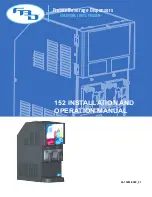
5
5. INSTALLATION
5.1 General Location Requirements
Dispenser is intended for indoor use only and should not be installed in areas where a waterjet can be used.
A flat, level location is required for proper installation. When using a counter, ensure it will support the weight
of the dispenser plus the weight of any equipment placed near it. See the specifications section for equipment
weights.
Note:
Maximum installation angle for surface placement should not exceed 8º for proper operation of
dispenser.
Adequate space above and behind the dispenser is required to allow:
1. Removal of side panels, if service is necessary.
2. Air circulation around vents on sides, back, and top of dispenser.
A well-ventilated room is required with a temperature of 50
°
F to 90
°
F (10
°
C to 32
°
C). The environment, howev-
er, should be stable and not subject to abrupt changes in temperature. The dispenser should not be exposed
to direct sunlight or chemicals.
5.2 Self-Contained Refrigeration Models
4.2 Unpacking
A.
Cut banding from shipping carton and remove carton by lifting up. Remove protective side panels
and four corner protectors.
B.
Remove drip tray assembly, accessory kit, and manual from top packaging. Contact the dealer if
any parts are missing or damaged.
C.
Remove side panels from dispenser.
D.
Inspect dispenser for concealed damage. If evident, immediately notify delivering carrier and file a
claim against same.
E.
Lift dispenser up by the frame cross bracing and remove lower portion of carton.
F.
If dispenser is received with a shipping board attached to the bottom, remove shipping board from
bottom of dispenser by accessing and removing the bolts located on the under side of the shipping
board.
4. RECEIVING AND UNPACKING DISPENSER
4.1 Receiving
Each dispenser is tested and thoroughly inspected before shipment. At the time of shipment, the carrier
accepts the dispenser and any claim for damages must be made with the carrier. Upon receiving the dispens-
er from the delivering carrier, carefully inspect carton for visible indication of damage. If damage is present,
have carrier note same on bill of lading and file a claim with the carrier.
Adequate clearance around the dispenser is required for proper air flow. Failure to provide proper clearance
will reduce capacity and can eventually damage the refrigeration system. See the specifications page for
clearance requirements. Be careful of enclosed installations that can recirculate hot discharge air. Such
installations require supplemental ventilation to remove the hot discharge air. A fan with a thermal switch is
a good option.
Although the dispenser can operate in temperatures up to 104°F (40°C), an ambient temperature of 75°F
(24°C) provides the optimal capacity. As the ambient temperature increases, the dispenser capacity decreas-
es. A self-contained, air-cooled dispenser can release a large amount of heat into the environment; therefore,it
is essential that the HVAC system be able to handle this heat load.







































